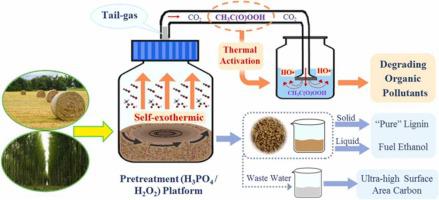Journal of Hazardous Materials ( IF 12.2 ) Pub Date : 2021-10-15 , DOI: 10.1016/j.jhazmat.2021.127517 Miao Lei 1 , Fei Shen 1 , Jinguang Hu 2 , Li Zhao 1 , Mei Huang 1 , Jianmei Zou 1 , Dong Tian 1 , Gang Yang 1 , Yongmei Zeng 1 , Shihuai Deng 1

|
The abundantly released tail-gas from lignocellulose pretreatment with phosphoric acid plus hydrogen peroxide (PHP) was found to accelerate the aging of latex/silicone textural accessories of the pretreatment device. Inspired by this, tail-gas was utilized to control organic pollutants. Methylene blue (MB), as a model pollutant, was rapidly decolorized by the tail-gas, and oxidative degradation was substantially proven by full-wavelength scanning with a UV–visible spectrometer. The tail-gas from six typical lignocellulosic feedstocks produced 68.0–98.3% MB degradation, suggesting its wide feedstock compatibility. Three other dyes, including rhodamine B, methyl orange and malachite green, obtained 97.5–99.5% degradation; moreover, tetracycline, resorcinol and hexachlorobenzene achieved 73.8–93.7% degradation, suggesting a superior pollutant compatibility. In a cytotoxicity assessment, the survival rate of the degraded MB was 103.5% compared with 80.4% for the untreated MB, implying almost no cytotoxicity after MB degradation. Mechanism investigations indicated that the self-exothermic reaction in PHP pretreatment drove the self-generated peroxy acids into tail-gas. Moreover, it heated the pollutant solution and thermally activated peroxy acids as free radicals for efficient pollutant degradation. Here, a brand-new technique for degrading organic pollutants with a “Win–Win–Win” concept was purposed for lignocellulose valorization, pollutant control by waste tail-gas, and biofuel production.
中文翻译:

PHP(磷酸加过氧化氢)预处理木质纤维素尾气轻松降解有机污染物的新方法
发现用磷酸加过氧化氢 (PHP) 预处理木质纤维素后大量释放的尾气会加速预处理装置的乳胶/有机硅纹理附件的老化。受此启发,尾气被用于控制有机污染物。亚甲基蓝(MB)作为一种模型污染物,被尾气迅速脱色,并且通过紫外-可见光谱仪的全波长扫描基本证明了氧化降解。来自六种典型木质纤维素原料的尾气产生了 68.0-98.3% 的 MB 降解,表明其具有广泛的原料兼容性。其他三种染料,包括罗丹明 B、甲基橙和孔雀石绿,降解率为 97.5-99.5%;此外,四环素、间苯二酚和六氯苯的降解率为 73.8-93.7%,表明优越的污染物相容性。在细胞毒性评估中,降解 MB 的存活率为 103.5%,而未处理 MB 的存活率为 80.4%,这意味着 MB 降解后几乎没有细胞毒性。机理研究表明,PHP预处理中的自放热反应驱使自生过氧酸进入尾气。此外,它加热污染物溶液并热活化过氧酸作为自由基,以有效降解污染物。在这里,一种全新的“双赢”理念的有机污染物降解技术被用于木质纤维素增值、废气尾气污染物控制和生物燃料生产。意味着MB降解后几乎没有细胞毒性。机理研究表明,PHP预处理中的自放热反应驱使自生过氧酸进入尾气。此外,它加热污染物溶液并热活化过氧酸作为自由基,以有效降解污染物。在这里,一种全新的“双赢”理念的有机污染物降解技术被用于木质纤维素增值、废气尾气污染物控制和生物燃料生产。意味着MB降解后几乎没有细胞毒性。机理研究表明,PHP预处理中的自放热反应驱使自生过氧酸进入尾气。此外,它加热污染物溶液并热活化过氧酸作为自由基,以有效降解污染物。在这里,一种全新的“双赢”理念的有机污染物降解技术被用于木质纤维素增值、废气尾气污染物控制和生物燃料生产。











































 京公网安备 11010802027423号
京公网安备 11010802027423号